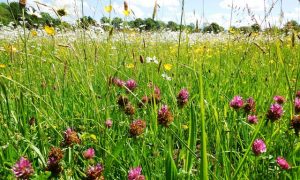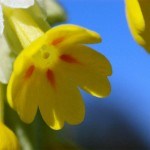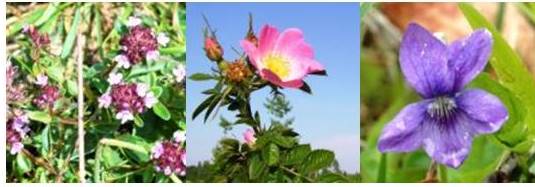
Great news – we are just over £500 from our first target for the Fairy Meadow Fund ! This fighting fund will help us buy wildlife-poor land and turn it into new meadows rich in wildflowers for families and children to enjoy, and has now reached £19,454. Please help us hit our first target of £20,000 so that we can start looking for land to buy and re-sow with native British wildflowers.
Donate online at our Fairy Meadow Fund page today, or via the donate button
Please help the bee add some more honey to reach our first target !
Why Midsummer ?
This is the very best time of year to go out and visit wildflower-rich grasslands of the sort that used to be traditional places for picnics and play for our grandparents and great-grandparents.

Solstice Daisies, so-called as they are in flower at Mid-Summer, reaching for the sun at Fritton Common in Norfolk
In June and July, meadows, commons and downlands are at their best as a succession of different wildflowers come into bloom and they buzz with bees and flutter with butterflies. Have look at the photos of some flower rich grasslands and see places to visit at the Fairy Meadow Fund page.

Did you know that more than 97% of out traditional lowland hay meadows have been lost ? That makes it so much harder for parents to introduce their children to nature, and even to find a flower rich grassland for family walk or outing. It also drives many of our wild plants, flowers and the wildlife taht depend upon them, towards extinction. But it is possible to re-create similar if never quite identical meadows and that’s what the Fairy Meadow Fund is for.

Cowslips on a resown pasture at Courtyard Farm, Norfolk
Midsummer is a very magical time by tradition associated with the peak of fairy activity. This year the Summer Solstice, the longest day, is on Monday 20 June and so we are launching our Fairy Meadow Fund Midsummer Appeal now to try and close that gap to our first target of £20,000.
Flower rich meadows and waysides are a vivid part of our heritage and national memory and should be a vital children’s future. Shakespeare’s play A Midsummer Nights Dream, is full of mentions of wild flowers, which would have been common at the time and a part of everyday life well known to his audiences. Today many are far rarer.
In A Midsummer Nights Dream, The Fairy tells the magical sprite Puck (Robin Goodfellow):
And I serve the Fairy Queen,
To dew her orbs upon the green.
The cowslips tall her pensioners be;
In their gold coats spots you see;
Those be rubies, fairy favours,
In those freckles live their savours.
I must go seek some dewdrops here,
And hang a pearl in every cowslip’s ear.
Rubies refer to the red spots on Cowslip petals.

Most famously though, Oberon the Fairy King describes the place where his queen, Titania sleeps :
I know a bank where the wild thyme blows,
Where oxlips and the nodding violet grows,
Quite over-canopied with luscious woodbine,
With sweet musk-roses, and with eglantine;
There sleeps Titania sometime of the night,
Lull’d in these flowers with dances and delight
(Act II, Scene I, A Midsummer Night’s Dream)
There are now few banks where the ‘wild thyme blows’, not so many people can tell Eglantine from a Dog Rose and most children don’t get a chance to sniff a real wild Sweet Violet but through the Fairy Meadow Fund we hope to bring some of these treasures back so more people can share and experience them.

Above: Wild Thyme, Englantine (Sweet Briar), and Sweet Violet






